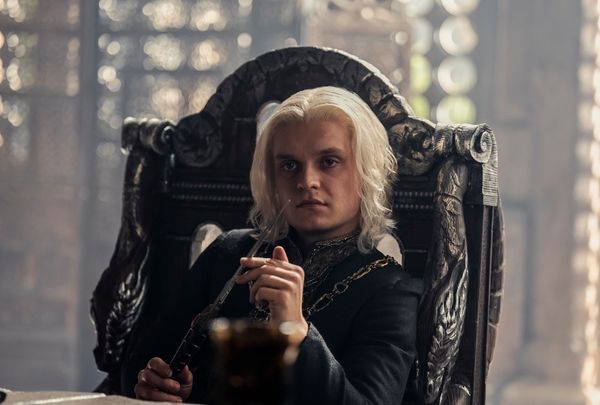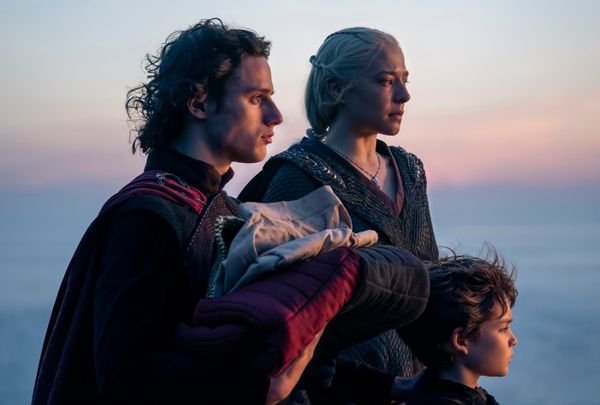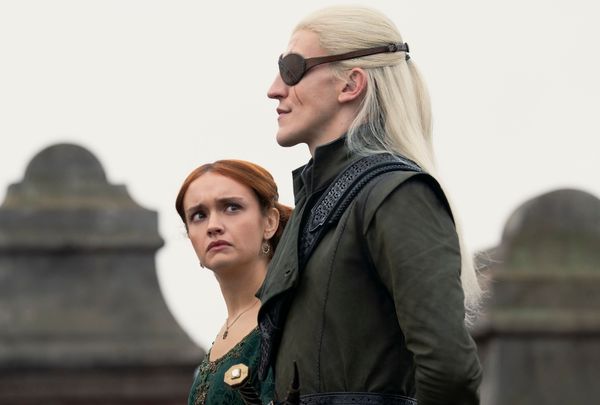About two years passed between the first season of “House of the Dragon” and the second, long enough to either whet our hunger for what we were missing or make us realize that we had forgotten about it entirely.
For many of us, I suspect it’s a bit of both, in that enough of us watched the first season to make it a gargantuan success without ever understanding precisely why we continued watching.
Some people are just here for the dragons and the violence, and if that describes you, rejoice: each new episode this season is peppered with villainy, with the fourth finally serving up the fire and blood promised by George RR’s previous book Martin. But the same setbacks that marked the first season haven’t been improved enough to rekindle the passionate affection we once felt for its HBO predecessor.
One of the biggest complaints about Season 1 was the emphasis on court intrigue and slow-motion table-sitting to justify its existence. What’s the point? From the announcement, we knew what the main draw would be: dragons, dragons, dragons, fighting to the last flying wyrm.
But the emotional shock of a bloody war is only effective in measured doses. And war is what these chapters of Westerosi history promise.
 Tom Glynn Carney in “House of the Dragon” (HBO) (HBO)There’s also the unruly sprawl of the Targaryen bloodline and its allies and vassals to contend with, which requires a bit of refresher on who’s who and who did what. There are entire wikis dedicated to this goal, and it would be wise to have a few of these resources handy while you watch. (Everything is a multi-screen experience these days, amirite?) Nonetheless, here’s a quick summary for anyone who doesn’t have time to study or 10 hours to spare rewatching season 1.
Tom Glynn Carney in “House of the Dragon” (HBO) (HBO)There’s also the unruly sprawl of the Targaryen bloodline and its allies and vassals to contend with, which requires a bit of refresher on who’s who and who did what. There are entire wikis dedicated to this goal, and it would be wise to have a few of these resources handy while you watch. (Everything is a multi-screen experience these days, amirite?) Nonetheless, here’s a quick summary for anyone who doesn’t have time to study or 10 hours to spare rewatching season 1.
Some 172 years before Daenerys, the Targaryen dynasty ruled the kingdom more or less peacefully until the death of King Viserys I. Before Viserys became too frail for his judgment to be challenged, he named his daughter Rhaenyra Targaryen (Emma D ‘arcy) as his heir.
Rhaenyra’s ex-best friend, Alicent Hightower (Olivia Cooke), married Viserys, bore him two sons, and had a violent falling out with Rhaenyra. Their breakup leads Rhaenyra and her retinue to leave King’s Landing for the Targaryen seat of Dragonstone, where she is when she learns of her father’s death and that Alicent has claimed the throne for her son Aegon (Tom Glynn-Carney), Rhaenyra’s son. ‘ half brother.
This world has more dragons to show off, but less of the natural magic that made “Game of Thrones” a satisfying weekly destination.
This divides the House into two factions: the Greens, named after the house color of the Hightowers, and the Blacks, which refers to one of the colors of House Targaryen – although some believe it refers to the black hair of Rhaenyra’s illegitimate sons.
A few snipes, beatings and bullying sessions later, Aegon’s brother Prince Aemond (Ewan Mitchell) is riding his dragon Vhagar, the largest in the kingdom, when Vhagar bites Aemond’s little nephew Lucerys and his dragon in full flight. The news coincides with Rhaenyra miscarrying another child in as grotesque a way as television can imagine.
 Harry Collett, Emma D’arcy and Oscar Eskinazi in ‘House of the Dragon’ (HBO) (HBO)Nevertheless, some optimists in the world (and perhaps in the public) wonder whether peace can be salvaged from this shipwreck. This dilemma dominates the small councils of Dragonstone and King’s Landing. Rhaenyra’s bloodthirsty prince consort and uncle-husband, Daemon (Matt Smith), is eager for revenge, while Rhaenyra’s cousin, Rhaenys (Eve Best), advises caution and patience. Alicent and his father Otto Hightower (Rhys Ifans) do what they can to rein in Aegon, who cannot accept that his grip on the Iron Throne is tenuous.
Harry Collett, Emma D’arcy and Oscar Eskinazi in ‘House of the Dragon’ (HBO) (HBO)Nevertheless, some optimists in the world (and perhaps in the public) wonder whether peace can be salvaged from this shipwreck. This dilemma dominates the small councils of Dragonstone and King’s Landing. Rhaenyra’s bloodthirsty prince consort and uncle-husband, Daemon (Matt Smith), is eager for revenge, while Rhaenyra’s cousin, Rhaenys (Eve Best), advises caution and patience. Alicent and his father Otto Hightower (Rhys Ifans) do what they can to rein in Aegon, who cannot accept that his grip on the Iron Throne is tenuous.
Almost everyone who matters gets spoiled, especially the public. Dismantling this tension leads to Wagnerian operatic angst over what might, should, could, and should happen, interrupted by singular, brutal acts that make large-scale violence inevitable.
This foreshadows fiery conflagrations in the air between the legends that appear in “Game of Thrones” as skulls and bones. Provided we can bring ourselves to empathize with people riding these magnificent monsters or dodging their fire, that may be enough to sustain these eight episodes. But that’s the weak point in this series’ arsenal. Since we’ve never had any meaningful insight into the motivations or moral triggers of each of these players, too many of these Targaryens, Velaryons, Greens, Blacks, Strongs and the like are useless.
The emotional shock of a bloody war is only effective in measured doses. And war is what these chapters of Westerosi history promise.
A few top artists expend enough energy and warmth that their work is worth savoring. This primarily refers to D’Arcy and Cooke, whose characters’ grief and grievances imprison them and their relative helplessness.
But despite the palpable pain and regret these actors wrest from each other, their queens are also relegated to the periphery of the action, ceding dominance to one-note characters. Smith’s range is limited to the extremes of rage and furious sadism, although, curiously, his work allowed me to appreciate the dimension Mitchell lends to Aemond’s brooding and malevolence.
 Olivia Cooke and Ewan Mitchell in “House of the Dragon” (HBO) (HBO)At the same time, it is always difficult to care about others. For example, two very kind and noble men find themselves drawn into a horrible confrontation that ends miserably for both of them, with one of them walking out crying. But no matter how hard they tried, the best I could muster at the end of their sweaty, bloody passion play was: “Ouch.”
Olivia Cooke and Ewan Mitchell in “House of the Dragon” (HBO) (HBO)At the same time, it is always difficult to care about others. For example, two very kind and noble men find themselves drawn into a horrible confrontation that ends miserably for both of them, with one of them walking out crying. But no matter how hard they tried, the best I could muster at the end of their sweaty, bloody passion play was: “Ouch.”
Again: it’s the mediocre writing that deserves to be blamed for this, not the performers. This world has more dragons to show off, but less of the natural magic that made “Game of Thrones” a satisfying weekly destination. I’m not talking about the sorcery of Essos, but the deep dives into each character’s humanity and weaknesses that strengthened the audience’s connection with them. The “Game of Thrones” scripts are equally enriched with humor and heart, but this “House” contains little, if any, of both.
Want a daily summary of all the news and commentary the Show has to offer? Subscribe to our morning newsletter, Crash Course.
Yet it also shows that Best is making the most of what she’s given by speaking volumes in her understated expressiveness. But aside from its dragon rider, Cooke’s disillusioned Queen Mother, and D’Arcy’s impotent ruler, few of the drama’s most important characters have enough meat on their bones to inspire our investment in their survival. Even Criston Cole, Fabien Frankel’s gentle look, doesn’t have much to work with other than sex and anger. You might be surprised how quickly this combo becomes tedious.
Terrible things happen in the service of Alicent and the Greens or Rhaenyra and the Blacks, including a barbaric act in the former that solidifies a point of no return. But a combination of thinly embroidered character interiority and the assumption that we know where this is all going makes each encounter feel like a roadside attraction on a precisely mapped highway.
“House of the Dragon” has already been renewed for a third season, and we may find that the second half of that finds a way to remedy the diluted storytelling that leaves us cold. The fourth episode fuels this hope even as the action within drains what remnants of assurance remain for the kingdom.
“House of the Dragon” season 2 premieres at 9 p.m. on Sunday, June 16 on HBO and Max.
Learn more
about this topic